Accounting and Finance for Managers: Performance and Investment Report
VerifiedAdded on 2019/12/04
|20
|4429
|130
Report
AI Summary
This report undertakes a comprehensive analysis of accounting and finance principles, focusing on comparative performance analysis and investment appraisal techniques. The first section delves into the financial performance of Next Plc and Hennes & Mauritz (H&M), utilizing various financial ratios such as current ratio, quick ratio, debt-equity ratio, inventory turnover, asset turnover, gross margin, net margin, return on equity, and operating cash flow per share to evaluate their financial health and efficiency. Non-financial aspects, including EBITDA per employee, revenue per employee, staff turnover, and absenteeism, are also examined to provide a holistic view. The second part of the report focuses on investment appraisal, specifically for Hilltop Ltd, employing techniques like net cash flow, payback period, net present value (NPV), and accounting rate of return (ARR) to assess the viability of potential projects. The report concludes with recommendations for both companies, addressing areas for improvement, and acknowledges the limitations of the methods employed.
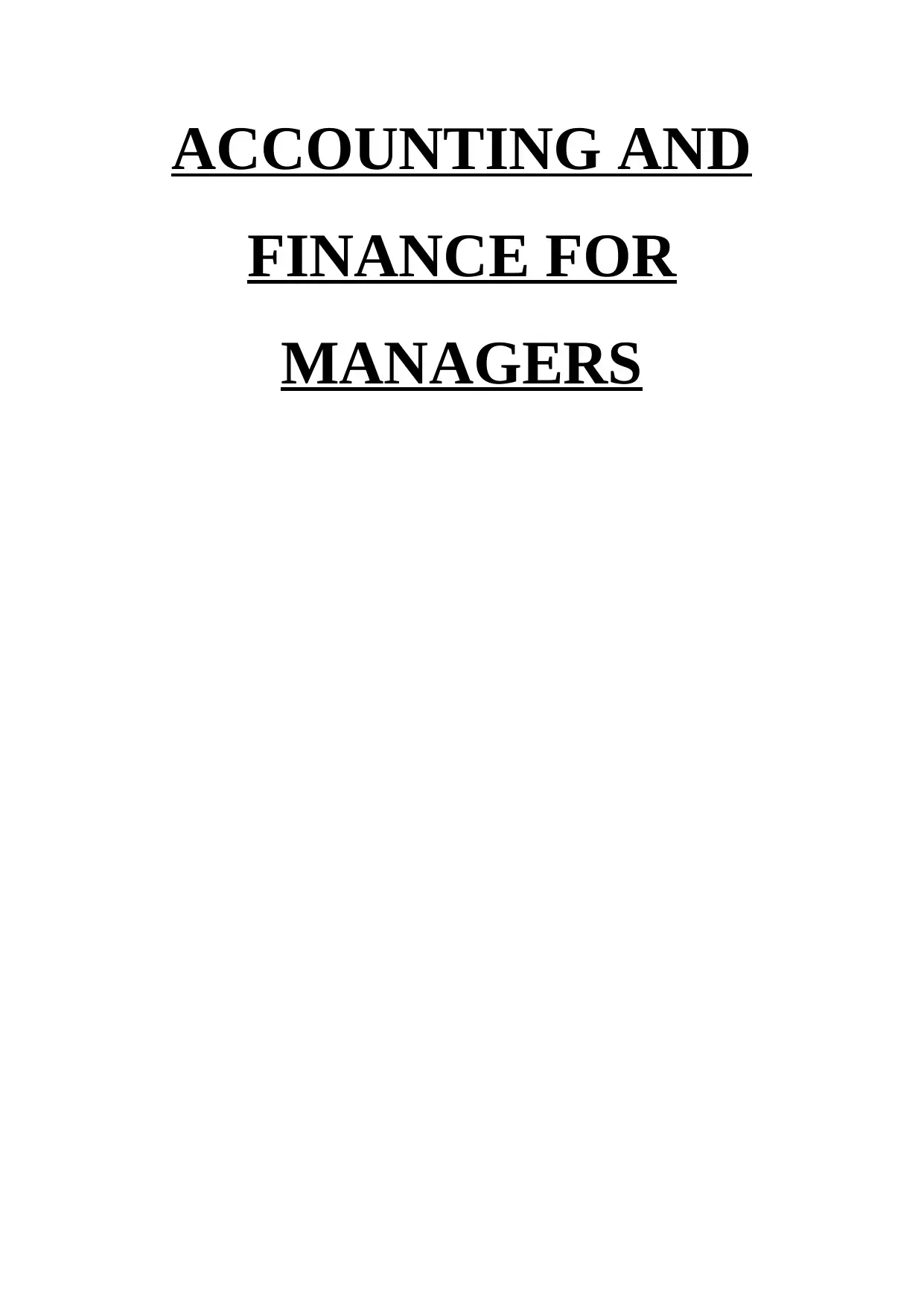
ACCOUNTING AND
FINANCE FOR
MANAGERS
FINANCE FOR
MANAGERS
Paraphrase This Document
Need a fresh take? Get an instant paraphrase of this document with our AI Paraphraser
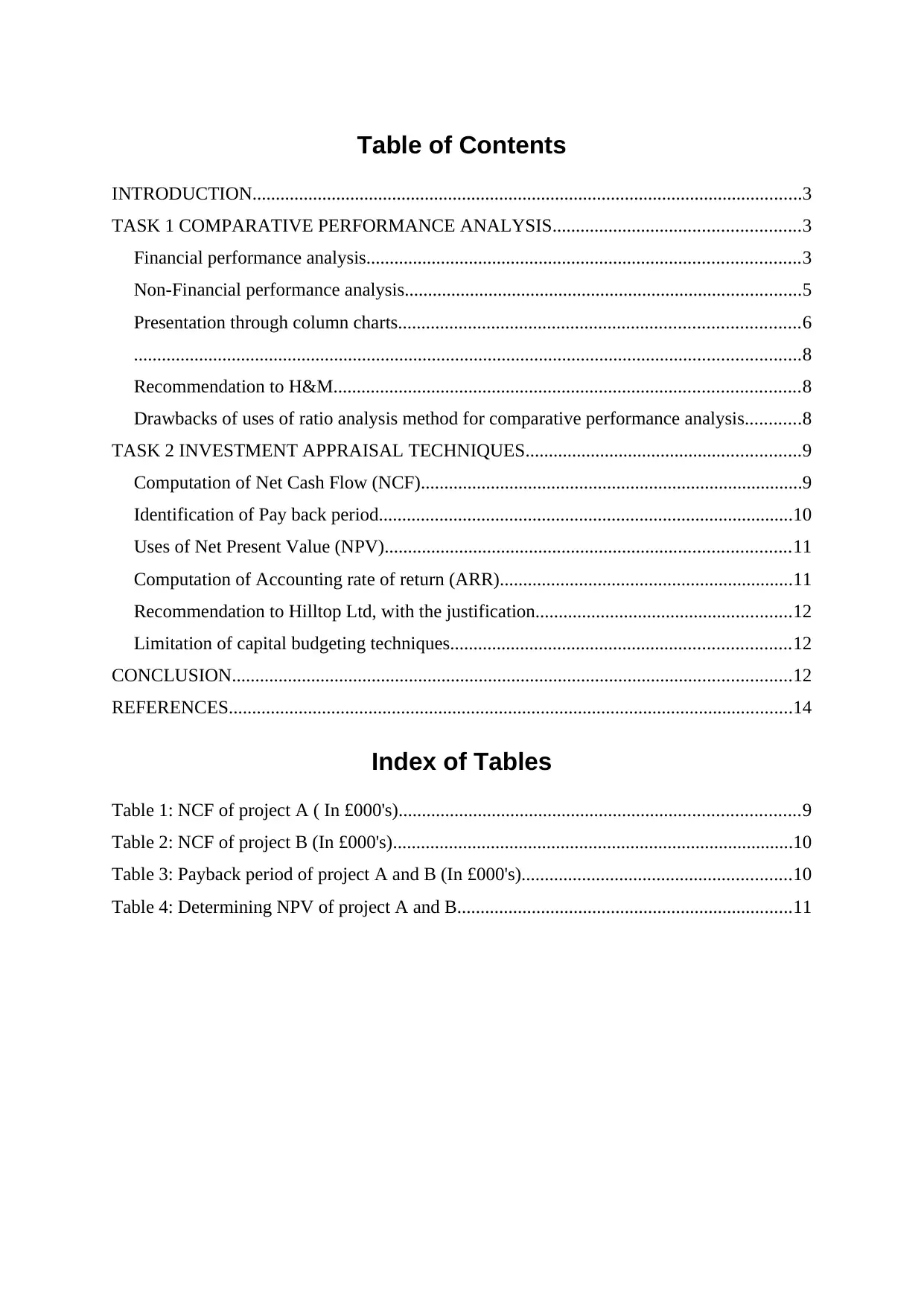
Table of Contents
INTRODUCTION......................................................................................................................3
TASK 1 COMPARATIVE PERFORMANCE ANALYSIS.....................................................3
Financial performance analysis.............................................................................................3
Non-Financial performance analysis.....................................................................................5
Presentation through column charts......................................................................................6
...............................................................................................................................................8
Recommendation to H&M....................................................................................................8
Drawbacks of uses of ratio analysis method for comparative performance analysis............8
TASK 2 INVESTMENT APPRAISAL TECHNIQUES...........................................................9
Computation of Net Cash Flow (NCF)..................................................................................9
Identification of Pay back period.........................................................................................10
Uses of Net Present Value (NPV).......................................................................................11
Computation of Accounting rate of return (ARR)...............................................................11
Recommendation to Hilltop Ltd, with the justification.......................................................12
Limitation of capital budgeting techniques.........................................................................12
CONCLUSION........................................................................................................................12
REFERENCES.........................................................................................................................14
Index of Tables
Table 1: NCF of project A ( In £000's)......................................................................................9
Table 2: NCF of project B (In £000's)......................................................................................10
Table 3: Payback period of project A and B (In £000's)..........................................................10
Table 4: Determining NPV of project A and B........................................................................11
INTRODUCTION......................................................................................................................3
TASK 1 COMPARATIVE PERFORMANCE ANALYSIS.....................................................3
Financial performance analysis.............................................................................................3
Non-Financial performance analysis.....................................................................................5
Presentation through column charts......................................................................................6
...............................................................................................................................................8
Recommendation to H&M....................................................................................................8
Drawbacks of uses of ratio analysis method for comparative performance analysis............8
TASK 2 INVESTMENT APPRAISAL TECHNIQUES...........................................................9
Computation of Net Cash Flow (NCF)..................................................................................9
Identification of Pay back period.........................................................................................10
Uses of Net Present Value (NPV).......................................................................................11
Computation of Accounting rate of return (ARR)...............................................................11
Recommendation to Hilltop Ltd, with the justification.......................................................12
Limitation of capital budgeting techniques.........................................................................12
CONCLUSION........................................................................................................................12
REFERENCES.........................................................................................................................14
Index of Tables
Table 1: NCF of project A ( In £000's)......................................................................................9
Table 2: NCF of project B (In £000's)......................................................................................10
Table 3: Payback period of project A and B (In £000's)..........................................................10
Table 4: Determining NPV of project A and B........................................................................11
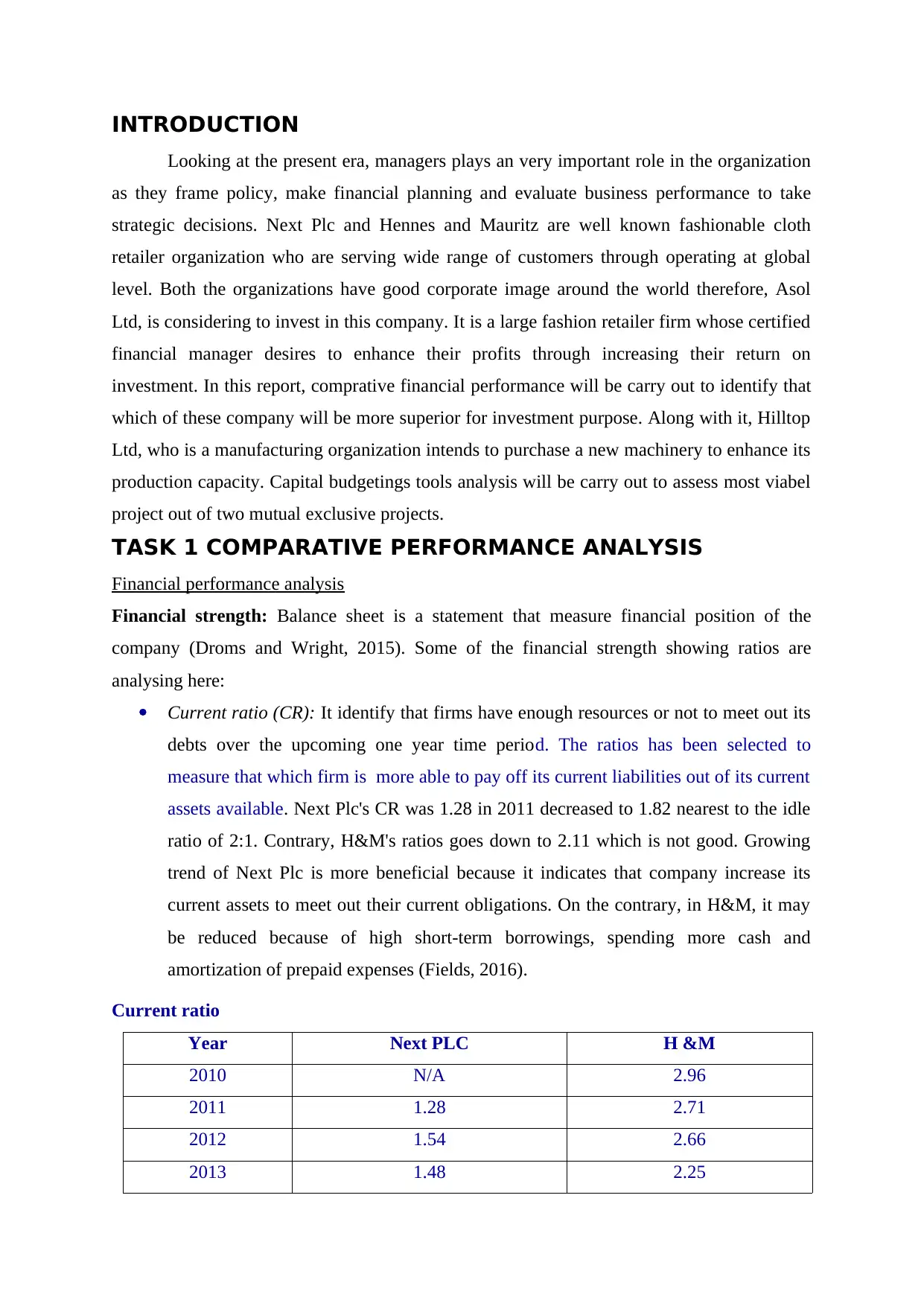
INTRODUCTION
Looking at the present era, managers plays an very important role in the organization
as they frame policy, make financial planning and evaluate business performance to take
strategic decisions. Next Plc and Hennes and Mauritz are well known fashionable cloth
retailer organization who are serving wide range of customers through operating at global
level. Both the organizations have good corporate image around the world therefore, Asol
Ltd, is considering to invest in this company. It is a large fashion retailer firm whose certified
financial manager desires to enhance their profits through increasing their return on
investment. In this report, comprative financial performance will be carry out to identify that
which of these company will be more superior for investment purpose. Along with it, Hilltop
Ltd, who is a manufacturing organization intends to purchase a new machinery to enhance its
production capacity. Capital budgetings tools analysis will be carry out to assess most viabel
project out of two mutual exclusive projects.
TASK 1 COMPARATIVE PERFORMANCE ANALYSIS
Financial performance analysis
Financial strength: Balance sheet is a statement that measure financial position of the
company (Droms and Wright, 2015). Some of the financial strength showing ratios are
analysing here:
Current ratio (CR): It identify that firms have enough resources or not to meet out its
debts over the upcoming one year time period. The ratios has been selected to
measure that which firm is more able to pay off its current liabilities out of its current
assets available. Next Plc's CR was 1.28 in 2011 decreased to 1.82 nearest to the idle
ratio of 2:1. Contrary, H&M's ratios goes down to 2.11 which is not good. Growing
trend of Next Plc is more beneficial because it indicates that company increase its
current assets to meet out their current obligations. On the contrary, in H&M, it may
be reduced because of high short-term borrowings, spending more cash and
amortization of prepaid expenses (Fields, 2016).
Current ratio
Year Next PLC H &M
2010 N/A 2.96
2011 1.28 2.71
2012 1.54 2.66
2013 1.48 2.25
Looking at the present era, managers plays an very important role in the organization
as they frame policy, make financial planning and evaluate business performance to take
strategic decisions. Next Plc and Hennes and Mauritz are well known fashionable cloth
retailer organization who are serving wide range of customers through operating at global
level. Both the organizations have good corporate image around the world therefore, Asol
Ltd, is considering to invest in this company. It is a large fashion retailer firm whose certified
financial manager desires to enhance their profits through increasing their return on
investment. In this report, comprative financial performance will be carry out to identify that
which of these company will be more superior for investment purpose. Along with it, Hilltop
Ltd, who is a manufacturing organization intends to purchase a new machinery to enhance its
production capacity. Capital budgetings tools analysis will be carry out to assess most viabel
project out of two mutual exclusive projects.
TASK 1 COMPARATIVE PERFORMANCE ANALYSIS
Financial performance analysis
Financial strength: Balance sheet is a statement that measure financial position of the
company (Droms and Wright, 2015). Some of the financial strength showing ratios are
analysing here:
Current ratio (CR): It identify that firms have enough resources or not to meet out its
debts over the upcoming one year time period. The ratios has been selected to
measure that which firm is more able to pay off its current liabilities out of its current
assets available. Next Plc's CR was 1.28 in 2011 decreased to 1.82 nearest to the idle
ratio of 2:1. Contrary, H&M's ratios goes down to 2.11 which is not good. Growing
trend of Next Plc is more beneficial because it indicates that company increase its
current assets to meet out their current obligations. On the contrary, in H&M, it may
be reduced because of high short-term borrowings, spending more cash and
amortization of prepaid expenses (Fields, 2016).
Current ratio
Year Next PLC H &M
2010 N/A 2.96
2011 1.28 2.71
2012 1.54 2.66
2013 1.48 2.25
⊘ This is a preview!⊘
Do you want full access?
Subscribe today to unlock all pages.

Trusted by 1+ million students worldwide
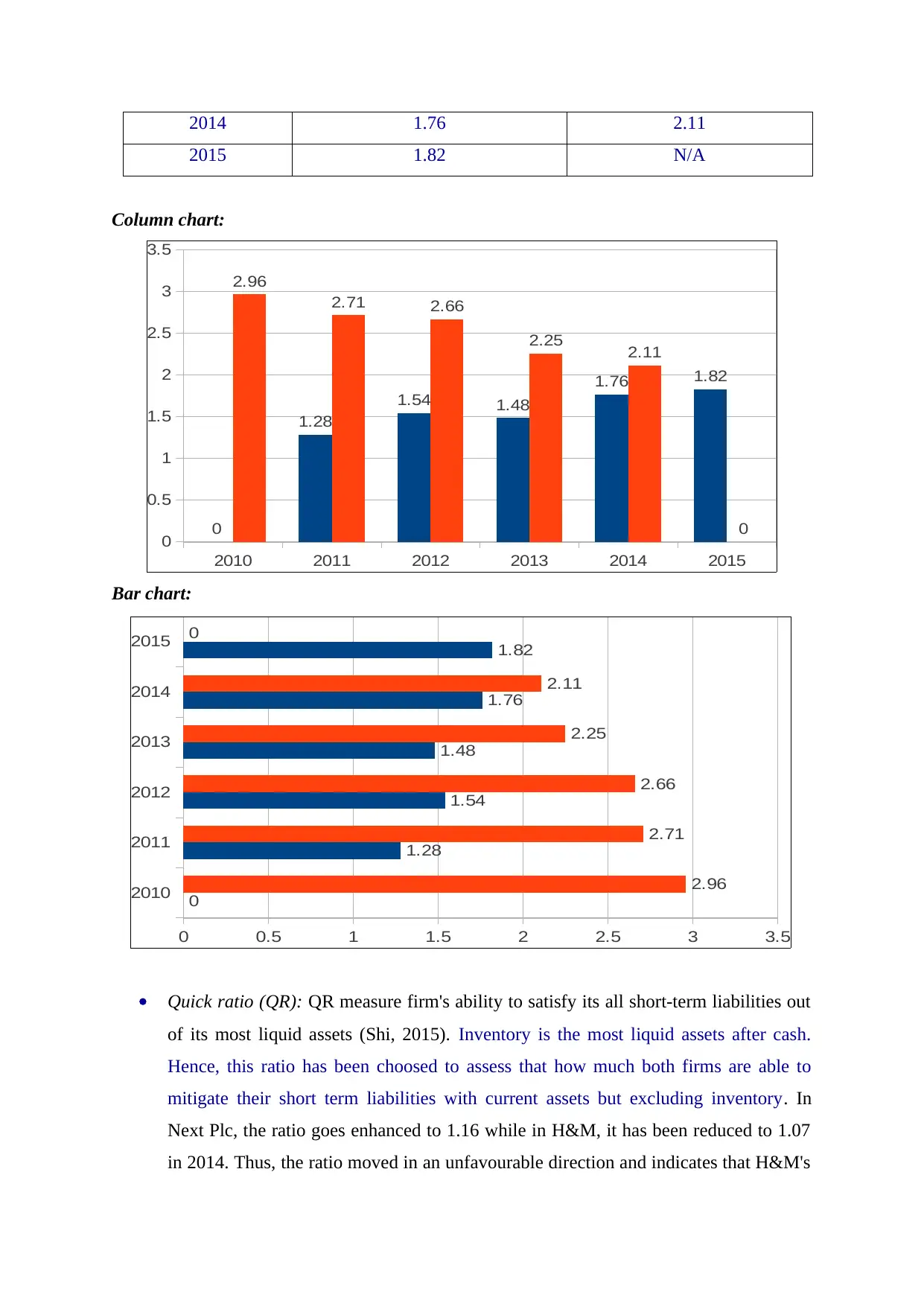
2014 1.76 2.11
2015 1.82 N/A
Column chart:
Bar chart:
Quick ratio (QR): QR measure firm's ability to satisfy its all short-term liabilities out
of its most liquid assets (Shi, 2015). Inventory is the most liquid assets after cash.
Hence, this ratio has been choosed to assess that how much both firms are able to
mitigate their short term liabilities with current assets but excluding inventory. In
Next Plc, the ratio goes enhanced to 1.16 while in H&M, it has been reduced to 1.07
in 2014. Thus, the ratio moved in an unfavourable direction and indicates that H&M's
2010 2011 2012 2013 2014 2015
0
0.5
1
1.5
2
2.5
3
3.5
0
1.28
1.54 1.48
1.76 1.82
2.96
2.71 2.66
2.25 2.11
0
2010
2011
2012
2013
2014
2015
0 0.5 1 1.5 2 2.5 3 3.5
0
1.28
1.54
1.48
1.76
1.82
2.96
2.71
2.66
2.25
2.11
0
2015 1.82 N/A
Column chart:
Bar chart:
Quick ratio (QR): QR measure firm's ability to satisfy its all short-term liabilities out
of its most liquid assets (Shi, 2015). Inventory is the most liquid assets after cash.
Hence, this ratio has been choosed to assess that how much both firms are able to
mitigate their short term liabilities with current assets but excluding inventory. In
Next Plc, the ratio goes enhanced to 1.16 while in H&M, it has been reduced to 1.07
in 2014. Thus, the ratio moved in an unfavourable direction and indicates that H&M's
2010 2011 2012 2013 2014 2015
0
0.5
1
1.5
2
2.5
3
3.5
0
1.28
1.54 1.48
1.76 1.82
2.96
2.71 2.66
2.25 2.11
0
2010
2011
2012
2013
2014
2015
0 0.5 1 1.5 2 2.5 3 3.5
0
1.28
1.54
1.48
1.76
1.82
2.96
2.71
2.66
2.25
2.11
0
Paraphrase This Document
Need a fresh take? Get an instant paraphrase of this document with our AI Paraphraser
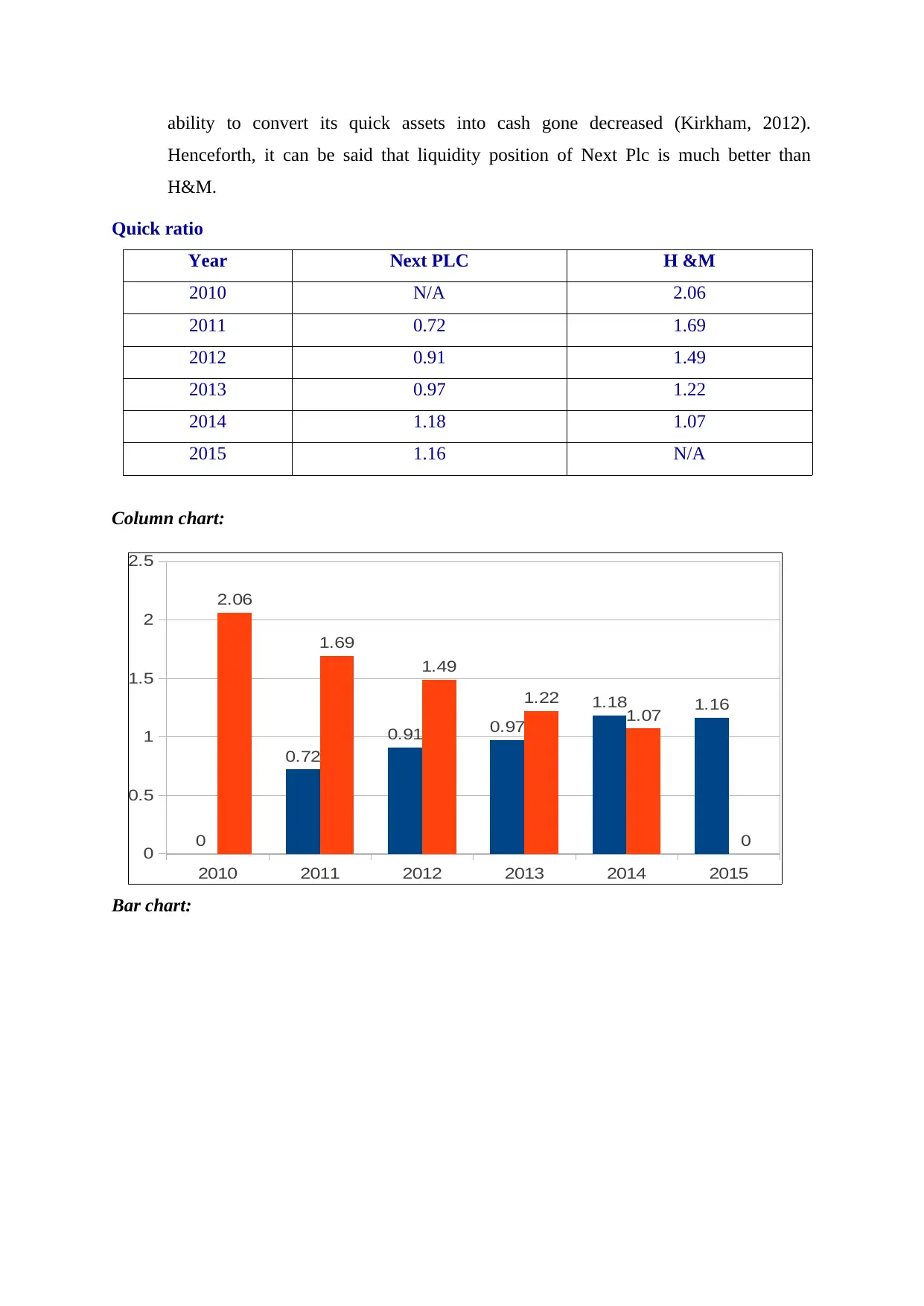
ability to convert its quick assets into cash gone decreased (Kirkham, 2012).
Henceforth, it can be said that liquidity position of Next Plc is much better than
H&M.
Quick ratio
Year Next PLC H &M
2010 N/A 2.06
2011 0.72 1.69
2012 0.91 1.49
2013 0.97 1.22
2014 1.18 1.07
2015 1.16 N/A
Column chart:
Bar chart:
2010 2011 2012 2013 2014 2015
0
0.5
1
1.5
2
2.5
0
0.72
0.91 0.97
1.18 1.16
2.06
1.69
1.49
1.22
1.07
0
Henceforth, it can be said that liquidity position of Next Plc is much better than
H&M.
Quick ratio
Year Next PLC H &M
2010 N/A 2.06
2011 0.72 1.69
2012 0.91 1.49
2013 0.97 1.22
2014 1.18 1.07
2015 1.16 N/A
Column chart:
Bar chart:
2010 2011 2012 2013 2014 2015
0
0.5
1
1.5
2
2.5
0
0.72
0.91 0.97
1.18 1.16
2.06
1.69
1.49
1.22
1.07
0
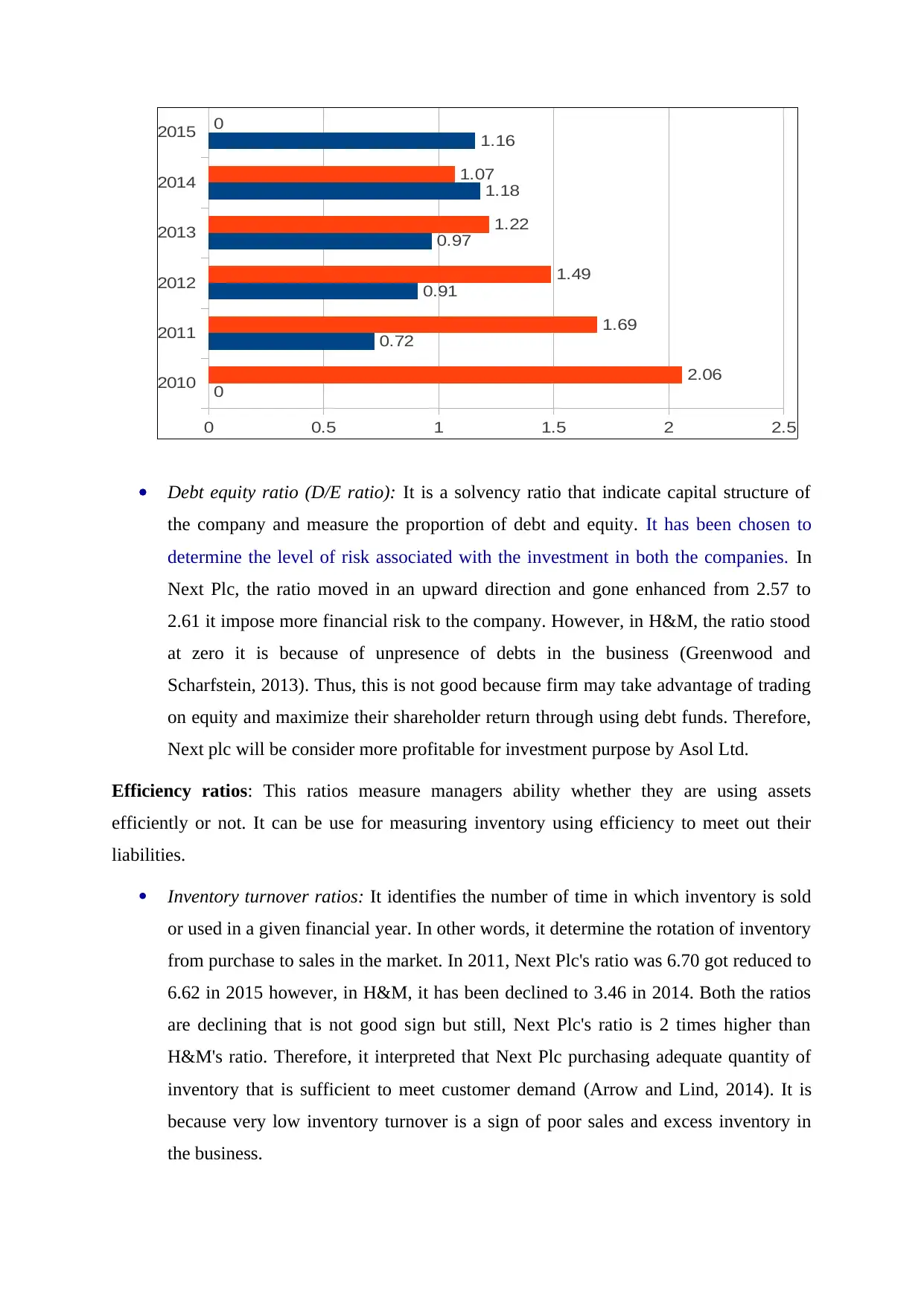
Debt equity ratio (D/E ratio): It is a solvency ratio that indicate capital structure of
the company and measure the proportion of debt and equity. It has been chosen to
determine the level of risk associated with the investment in both the companies. In
Next Plc, the ratio moved in an upward direction and gone enhanced from 2.57 to
2.61 it impose more financial risk to the company. However, in H&M, the ratio stood
at zero it is because of unpresence of debts in the business (Greenwood and
Scharfstein, 2013). Thus, this is not good because firm may take advantage of trading
on equity and maximize their shareholder return through using debt funds. Therefore,
Next plc will be consider more profitable for investment purpose by Asol Ltd.
Efficiency ratios: This ratios measure managers ability whether they are using assets
efficiently or not. It can be use for measuring inventory using efficiency to meet out their
liabilities.
Inventory turnover ratios: It identifies the number of time in which inventory is sold
or used in a given financial year. In other words, it determine the rotation of inventory
from purchase to sales in the market. In 2011, Next Plc's ratio was 6.70 got reduced to
6.62 in 2015 however, in H&M, it has been declined to 3.46 in 2014. Both the ratios
are declining that is not good sign but still, Next Plc's ratio is 2 times higher than
H&M's ratio. Therefore, it interpreted that Next Plc purchasing adequate quantity of
inventory that is sufficient to meet customer demand (Arrow and Lind, 2014). It is
because very low inventory turnover is a sign of poor sales and excess inventory in
the business.
2010
2011
2012
2013
2014
2015
0 0.5 1 1.5 2 2.5
0
0.72
0.91
0.97
1.18
1.16
2.06
1.69
1.49
1.22
1.07
0
the company and measure the proportion of debt and equity. It has been chosen to
determine the level of risk associated with the investment in both the companies. In
Next Plc, the ratio moved in an upward direction and gone enhanced from 2.57 to
2.61 it impose more financial risk to the company. However, in H&M, the ratio stood
at zero it is because of unpresence of debts in the business (Greenwood and
Scharfstein, 2013). Thus, this is not good because firm may take advantage of trading
on equity and maximize their shareholder return through using debt funds. Therefore,
Next plc will be consider more profitable for investment purpose by Asol Ltd.
Efficiency ratios: This ratios measure managers ability whether they are using assets
efficiently or not. It can be use for measuring inventory using efficiency to meet out their
liabilities.
Inventory turnover ratios: It identifies the number of time in which inventory is sold
or used in a given financial year. In other words, it determine the rotation of inventory
from purchase to sales in the market. In 2011, Next Plc's ratio was 6.70 got reduced to
6.62 in 2015 however, in H&M, it has been declined to 3.46 in 2014. Both the ratios
are declining that is not good sign but still, Next Plc's ratio is 2 times higher than
H&M's ratio. Therefore, it interpreted that Next Plc purchasing adequate quantity of
inventory that is sufficient to meet customer demand (Arrow and Lind, 2014). It is
because very low inventory turnover is a sign of poor sales and excess inventory in
the business.
2010
2011
2012
2013
2014
2015
0 0.5 1 1.5 2 2.5
0
0.72
0.91
0.97
1.18
1.16
2.06
1.69
1.49
1.22
1.07
0
⊘ This is a preview!⊘
Do you want full access?
Subscribe today to unlock all pages.

Trusted by 1+ million students worldwide

Year Next plc H&M
2010 0 3.7
2011 6.89 3.47
2012 6.47 3.37
2013 6.91 3.29
2014 6.97 3.46
2015 6.62 0
Column chart:
Bar chart:
2010 2011 2012 2013 2014 2015
0
1
2
3
4
5
6
7
8
0
6.89 6.47
6.91 6.97 6.62
3.7 3.47 3.37 3.29 3.46
0
2010
2011
2012
2013
2014
2015
0 1 2 3 4 5 6 7 8
0
6.89
6.47
6.91
6.97
6.62
3.7
3.47
3.37
3.29
3.46
0
2010 0 3.7
2011 6.89 3.47
2012 6.47 3.37
2013 6.91 3.29
2014 6.97 3.46
2015 6.62 0
Column chart:
Bar chart:
2010 2011 2012 2013 2014 2015
0
1
2
3
4
5
6
7
8
0
6.89 6.47
6.91 6.97 6.62
3.7 3.47 3.37 3.29 3.46
0
2010
2011
2012
2013
2014
2015
0 1 2 3 4 5 6 7 8
0
6.89
6.47
6.91
6.97
6.62
3.7
3.47
3.37
3.29
3.46
0
Paraphrase This Document
Need a fresh take? Get an instant paraphrase of this document with our AI Paraphraser

Assets turnover ratios: This ratio measure that in what extent firm is able to generate
sales through using this assets. In H&M, the ratio got increased from 1.91 to 2.14
while in Next Plc, it shows an declined trend as it reduced to 1.81 in 2015. Thus, it
indicates that H&M is using its business assets more efficiently than Next Plc.
Year Next plc H&M
2010 0 1.91
2011 1.89 1.84
2012 1.89 2.01
2013 1.89 2.04
2014 1.85 2.14
2015 1.81 0
Column chart:
Bar chart:
2010 2011 2012 2013 2014 2015
0
0.5
1
1.5
2
2.5
0
1.89 1.89 1.89 1.85 1.81
1.91 1.84
2.01 2.04 2.14
0
sales through using this assets. In H&M, the ratio got increased from 1.91 to 2.14
while in Next Plc, it shows an declined trend as it reduced to 1.81 in 2015. Thus, it
indicates that H&M is using its business assets more efficiently than Next Plc.
Year Next plc H&M
2010 0 1.91
2011 1.89 1.84
2012 1.89 2.01
2013 1.89 2.04
2014 1.85 2.14
2015 1.81 0
Column chart:
Bar chart:
2010 2011 2012 2013 2014 2015
0
0.5
1
1.5
2
2.5
0
1.89 1.89 1.89 1.85 1.81
1.91 1.84
2.01 2.04 2.14
0
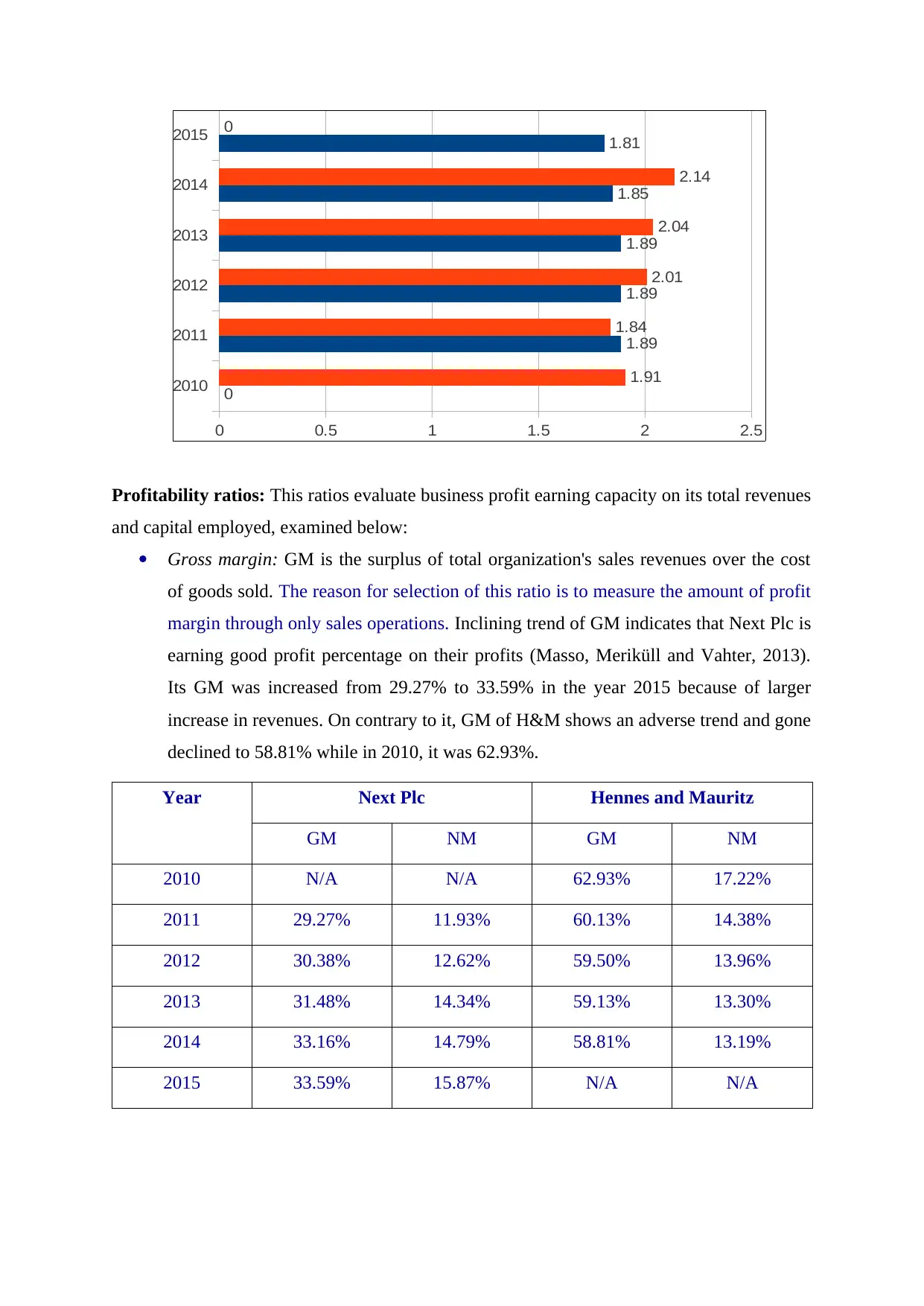
Profitability ratios: This ratios evaluate business profit earning capacity on its total revenues
and capital employed, examined below:
Gross margin: GM is the surplus of total organization's sales revenues over the cost
of goods sold. The reason for selection of this ratio is to measure the amount of profit
margin through only sales operations. Inclining trend of GM indicates that Next Plc is
earning good profit percentage on their profits (Masso, Meriküll and Vahter, 2013).
Its GM was increased from 29.27% to 33.59% in the year 2015 because of larger
increase in revenues. On contrary to it, GM of H&M shows an adverse trend and gone
declined to 58.81% while in 2010, it was 62.93%.
Year Next Plc Hennes and Mauritz
GM NM GM NM
2010 N/A N/A 62.93% 17.22%
2011 29.27% 11.93% 60.13% 14.38%
2012 30.38% 12.62% 59.50% 13.96%
2013 31.48% 14.34% 59.13% 13.30%
2014 33.16% 14.79% 58.81% 13.19%
2015 33.59% 15.87% N/A N/A
2010
2011
2012
2013
2014
2015
0 0.5 1 1.5 2 2.5
0
1.89
1.89
1.89
1.85
1.81
1.91
1.84
2.01
2.04
2.14
0
and capital employed, examined below:
Gross margin: GM is the surplus of total organization's sales revenues over the cost
of goods sold. The reason for selection of this ratio is to measure the amount of profit
margin through only sales operations. Inclining trend of GM indicates that Next Plc is
earning good profit percentage on their profits (Masso, Meriküll and Vahter, 2013).
Its GM was increased from 29.27% to 33.59% in the year 2015 because of larger
increase in revenues. On contrary to it, GM of H&M shows an adverse trend and gone
declined to 58.81% while in 2010, it was 62.93%.
Year Next Plc Hennes and Mauritz
GM NM GM NM
2010 N/A N/A 62.93% 17.22%
2011 29.27% 11.93% 60.13% 14.38%
2012 30.38% 12.62% 59.50% 13.96%
2013 31.48% 14.34% 59.13% 13.30%
2014 33.16% 14.79% 58.81% 13.19%
2015 33.59% 15.87% N/A N/A
2010
2011
2012
2013
2014
2015
0 0.5 1 1.5 2 2.5
0
1.89
1.89
1.89
1.85
1.81
1.91
1.84
2.01
2.04
2.14
0
⊘ This is a preview!⊘
Do you want full access?
Subscribe today to unlock all pages.

Trusted by 1+ million students worldwide

Column chart:
bar charts:
Net margin: NM is the balance of profits after covering all the business expenditures.
It has been selected to determine the amount and percentage of net earnings through
its overall business operations. In Next Plc, it was 11.93% in 2011 got increased to
15.87% in the year 2015. However, in H&M, the ratio demonstrating an adverse trend
and declined to 13.19%. It may be because of lower revenues and high administrating,
selling and distribution and other operating expenses. Hence, the ratio interpreted that
Next Plc is performing well as compare to H&M.
2010 2011 2012 2013 2014 2015
0
0.1
0.2
0.3
0.4
0.5
0.6
0.7
0
29.27% 30.38% 31.48% 33.16% 33.59%
62.93% 60.13% 59.50% 59.13% 58.81%
0
2010
2011
2012
2013
2014
2015
0 0.1 0.2 0.3 0.4 0.5 0.6 0.7
0
29.27%
30.38%
31.48%
33.16%
33.59%
62.93%
60.13%
59.50%
59.13%
58.81%
0
bar charts:
Net margin: NM is the balance of profits after covering all the business expenditures.
It has been selected to determine the amount and percentage of net earnings through
its overall business operations. In Next Plc, it was 11.93% in 2011 got increased to
15.87% in the year 2015. However, in H&M, the ratio demonstrating an adverse trend
and declined to 13.19%. It may be because of lower revenues and high administrating,
selling and distribution and other operating expenses. Hence, the ratio interpreted that
Next Plc is performing well as compare to H&M.
2010 2011 2012 2013 2014 2015
0
0.1
0.2
0.3
0.4
0.5
0.6
0.7
0
29.27% 30.38% 31.48% 33.16% 33.59%
62.93% 60.13% 59.50% 59.13% 58.81%
0
2010
2011
2012
2013
2014
2015
0 0.1 0.2 0.3 0.4 0.5 0.6 0.7
0
29.27%
30.38%
31.48%
33.16%
33.59%
62.93%
60.13%
59.50%
59.13%
58.81%
0
Paraphrase This Document
Need a fresh take? Get an instant paraphrase of this document with our AI Paraphraser

Column chart:
Bar chart:
Management's effectiveness
Return on equity: It measure the profit percentage on total business equity in both the
firms. Investors often use this ratio to determine potential earnings on their
investment. In Next Plc, ratios moved in an unfavourable direction and reduced to
208.75% while in H&M business, it has been inclined to 41.27%. The direction is
favourable in H&M but still, in Next Plc, it is 5 times higher than H&M business. Its
reason are H&M has lower profits and using only the equity in its total capital
2010 2011 2012 2013 2014 2015
0
0.02
0.04
0.06
0.08
0.1
0.12
0.14
0.16
0.18
0.2
0
11.93% 12.62%
14.34% 14.79%
15.87%
17.22%
14.38% 13.96% 13.30% 13.19%
0
2010
2011
2012
2013
2014
2015
0 0.02 0.04 0.06 0.08 0.1 0.12 0.14 0.16 0.18 0.2
0
11.93%
12.62%
14.34%
14.79%
15.87%
17.22%
14.38%
13.96%
13.30%
13.19%
0
Bar chart:
Management's effectiveness
Return on equity: It measure the profit percentage on total business equity in both the
firms. Investors often use this ratio to determine potential earnings on their
investment. In Next Plc, ratios moved in an unfavourable direction and reduced to
208.75% while in H&M business, it has been inclined to 41.27%. The direction is
favourable in H&M but still, in Next Plc, it is 5 times higher than H&M business. Its
reason are H&M has lower profits and using only the equity in its total capital
2010 2011 2012 2013 2014 2015
0
0.02
0.04
0.06
0.08
0.1
0.12
0.14
0.16
0.18
0.2
0
11.93% 12.62%
14.34% 14.79%
15.87%
17.22%
14.38% 13.96% 13.30% 13.19%
0
2010
2011
2012
2013
2014
2015
0 0.02 0.04 0.06 0.08 0.1 0.12 0.14 0.16 0.18 0.2
0
11.93%
12.62%
14.34%
14.79%
15.87%
17.22%
14.38%
13.96%
13.30%
13.19%
0
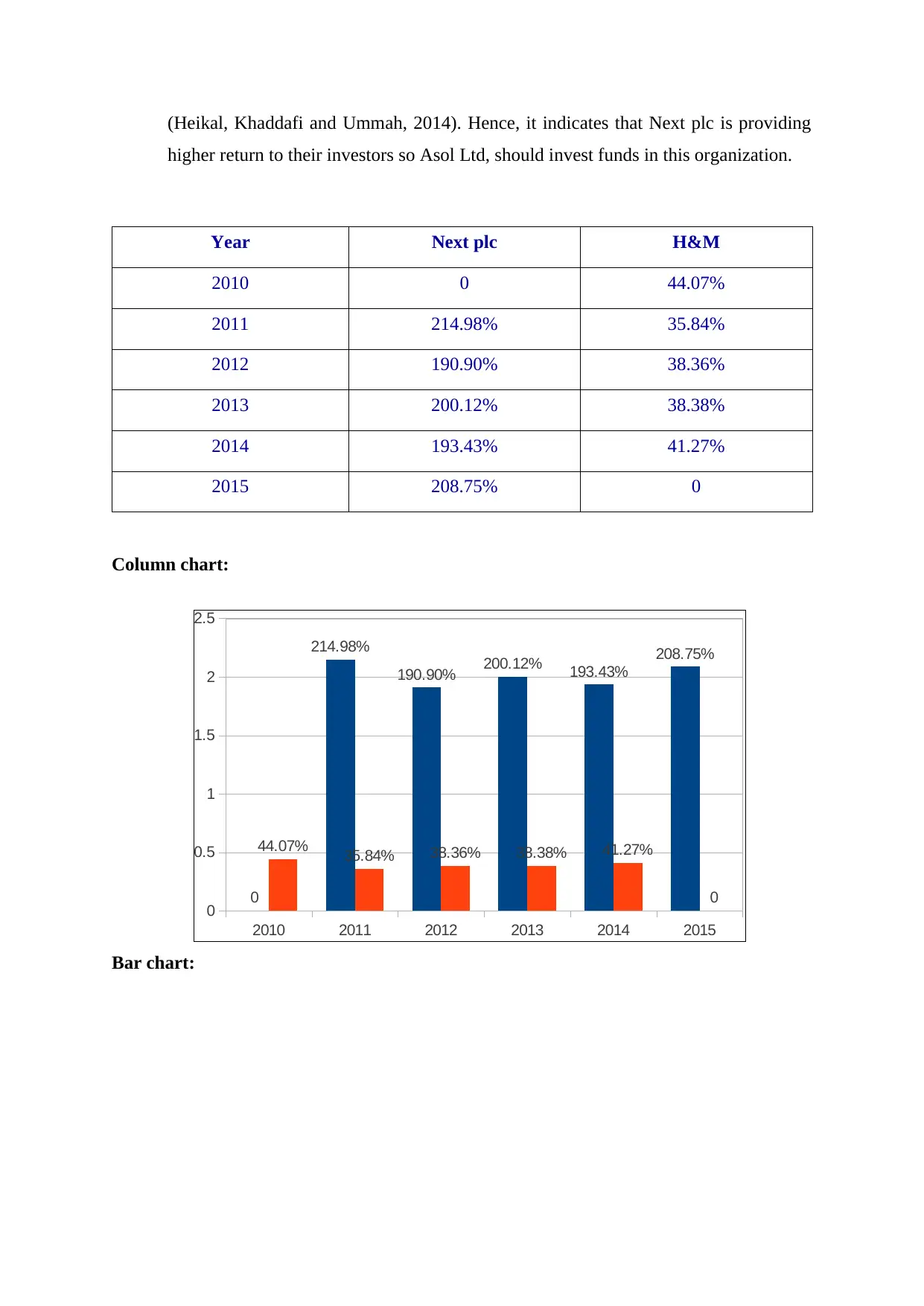
(Heikal, Khaddafi and Ummah, 2014). Hence, it indicates that Next plc is providing
higher return to their investors so Asol Ltd, should invest funds in this organization.
Year Next plc H&M
2010 0 44.07%
2011 214.98% 35.84%
2012 190.90% 38.36%
2013 200.12% 38.38%
2014 193.43% 41.27%
2015 208.75% 0
Column chart:
Bar chart:
2010 2011 2012 2013 2014 2015
0
0.5
1
1.5
2
2.5
0
214.98%
190.90% 200.12% 193.43%
208.75%
44.07% 35.84% 38.36% 38.38% 41.27%
0
higher return to their investors so Asol Ltd, should invest funds in this organization.
Year Next plc H&M
2010 0 44.07%
2011 214.98% 35.84%
2012 190.90% 38.36%
2013 200.12% 38.38%
2014 193.43% 41.27%
2015 208.75% 0
Column chart:
Bar chart:
2010 2011 2012 2013 2014 2015
0
0.5
1
1.5
2
2.5
0
214.98%
190.90% 200.12% 193.43%
208.75%
44.07% 35.84% 38.36% 38.38% 41.27%
0
⊘ This is a preview!⊘
Do you want full access?
Subscribe today to unlock all pages.

Trusted by 1+ million students worldwide
1 out of 20
Related Documents
Your All-in-One AI-Powered Toolkit for Academic Success.
+13062052269
info@desklib.com
Available 24*7 on WhatsApp / Email
![[object Object]](/_next/static/media/star-bottom.7253800d.svg)
Unlock your academic potential
Copyright © 2020–2025 A2Z Services. All Rights Reserved. Developed and managed by ZUCOL.





